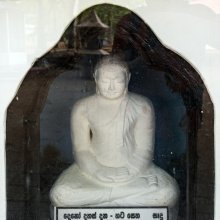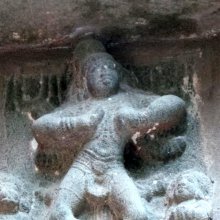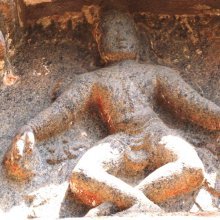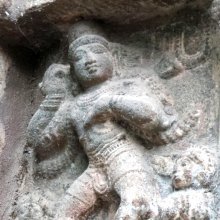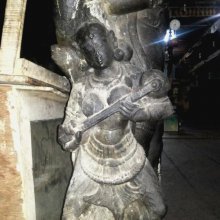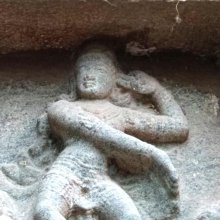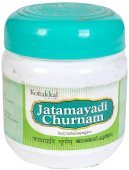Nata, Ñāta, Naṭa, Natā, Ñātā: 35 definitions
Introduction:
Nata means something in Buddhism, Pali, Hinduism, Sanskrit, Jainism, Prakrit, the history of ancient India, Marathi, Hindi, biology, Tamil. If you want to know the exact meaning, history, etymology or English translation of this term then check out the descriptions on this page. Add your comment or reference to a book if you want to contribute to this summary article.
Images (photo gallery)
(+116 more images available)
In Hinduism
Natyashastra (theatrics and dramaturgy)
Source: Wisdom Library: Nāṭya-śāstra1) Naṭa (नट) refers to an “actor” of a dramatic play (nāṭya), according to the Nāṭyaśāstra chapter 35. Accordingly, “an actor (naṭa) should be lively (lit. bright), possessed of a good physique, acquainted with theatrical accessories and their uses, possessed of intelligence, conversant with the rules of the theoretical practice, and expert in his own work”. According to verse 35.100, “definition of an actor (naṭa).—one who can apply the music of four kinds of instrument, and produce a play according to the meaning of the Śāstra as well as his own reasoning, is called an actor (naṭa)”.
2a) Natā (नता, “inclined”) refers to a specific gesture (āṅgika) made with the nose (nāsā), according to the Nāṭyaśāstra chapter 8. These gestures form a part of the histrionic representation (abhinaya). (Instructions): “lobes cling for a while to the base”. (Uses): “in slight weeping at intervals”.
2b) Natā (नता, “bent”) refers to a specific gesture (āṅgika) made with the neck (grīvā), according to the Nāṭyaśāstra chapter 8. These ‘gestures of the neck (grīvā)’ should follow the gestures made with the head (śiras). These gestures form a part of the histrionic representation (abhinaya). ( Instructions): “neck with face bent down”. (Uses): “in wearing (lit. binding) ornaments, putting one’s arms round (lit. taking) somebody’s neck”.
3a) Nata (नत, “bent”) refers to a specific gesture (āṅgika) made with the sides (pārśva), according to the Nāṭyaśāstra chapter 10. The sides are one of the six major limbs (aṅga) used to perform certain gestures (āṅgika). These gestures form a part of the histrionic representation (abhinaya). (Instructions): “the waist slightly bent, one side slightly bent, one shoulder drawn away slightly”. (Uses): “in approaching any body”.
3b) Nata (नत, “bent”) also refers to a specific gesture (āṅgika) made with the shank (jaṅghā), according to the Nāṭyaśāstra chapter 10. These gestures form a part of the histrionic representation (abhinaya). (Instructions): “the knee bent”. (Uses): “in assuming sthāna (standing) and āsana (sitting) postures”.
3c) Nata (नत) also refers to a type of lying-down posture (śayana); it is a Sanskrit technical term defined in the Nāṭyaśāstra chapter 12. (Instructions): “lying down with the legs (lit. shanks) slightly stretched and the two hands loosely resting is called the nata posture. It is to be used in laziness, fatigue and distress”.
Source: archive.org: The mirror of gesture (abhinaya-darpana)The Dancer or Actor (naṭa).—Wise men say the Dancer (or actor) should be handsome, of sweet speech, learned, capable, eloquent, of good birth, learned in the scriptures (śāstras) of art and science, of sweet voice, versed in song, instrumental music, and dancing, self-confident, and of ready wit.
Source: Shodhganga: Elements of Art and Architecture in the Trtiyakhanda of the Visnudharmottarapurana (natya)1) Nata (नत) refers to one of the “five kinds of side-movements” (in Sanskrit Dramas), as conveyed through Āṅgikābhinaya: one of the four divisions of Abhinaya or “ways to convey or represent one’s emotion to others”, according to the Viṣṇudharmottarapurāṇa, an ancient Sanskrit text which (being encyclopedic in nature) deals with a variety of cultural topics such as arts, architecture, music, grammar and astronomy.—The āṅgikābhinaya includes the histrionic representation of the limbs which is simply known as physical gestures. There are five kinds of side movements accepted in the Viṣṇudharmottarapurāṇa. The term nata denotes the action of saluting someone. According to the Viṣṇudharmottarapurāṇa nata movement is adopted in approaching someone.
2) Natā (नता) also refers to one of the “six movements of the nose”.—In the Viṣṇudharmottarapurāṇa as well as in the Nāṭyaśāstra, the varieties of nose movements have been mentioned in feminine gender. The natā movement (i.e., “bent nostrils”) denote pleasant state.
3) Nata (नत) also refers to one of the nine kinds of śayyāsthāna or “lying down postures”.—In the Viṣṇudharmottarapurāṇa, nine kinds of upaveśana i.e., sitting postures are accepted for Drama. Some particular postures are recommended in the Viṣṇudharmottarapurāṇa as śayyāsthāna, which are adopted by the actors at time of lying down in a Drama. The nata posture is used to show laziness, tiredness and physical exertion by loosing hands and strengthening the thighs.
4) Nata (नत) refers to one of the 108 kinds of Karaṇa (“coordination of precise movements of legs and hands”), according to the Viṣṇudharmottarapurāṇa.—Accordingly, karaṇas are the coordination of precise movements of legs and hands performed in a particular posture. The Nāṭyaśāstra also gives its view point in the same spirit. In the Viṣṇudharmottarapurāṇa, one hundred and eight kinds of karaṇas are accepted, e.g., Nata.

Natyashastra (नाट्यशास्त्र, nāṭyaśāstra) refers to both the ancient Indian tradition (shastra) of performing arts, (natya—theatrics, drama, dance, music), as well as the name of a Sanskrit work dealing with these subjects. It also teaches the rules for composing Dramatic plays (nataka), construction and performance of Theater, and Poetic works (kavya).
Vyakarana (Sanskrit grammar)
Source: Wikisource: A dictionary of Sanskrit grammarNata (नत).—Cerebralized; changed into ण् (ṇ). The change of the consonant न् (n) into ण् (ṇ) is called नति (nati) in the old Pratisakhya works; cf. स्पर्शे वोष्मणि चानते (sparśe voṣmaṇi cānate) R. Pr. IV. 11.

Vyakarana (व्याकरण, vyākaraṇa) refers to Sanskrit grammar and represents one of the six additional sciences (vedanga) to be studied along with the Vedas. Vyakarana concerns itself with the rules of Sanskrit grammar and linguistic analysis in order to establish the correct context of words and sentences.
Purana and Itihasa (epic history)
Source: archive.org: Nilamata Purana: a cultural and literary studyNaṭa (नट, “actors”) refers to one of the sub-castes that once existed in ancient Kashmir (Kaśmīra) as mentioned in the Nīlamatapurāṇa.
Source: archive.org: Shiva Purana - English TranslationNaṭa (नट) refers to “actors” whose company was associated unfavourably for the religiously devoted, according to the Śivapurāṇa 2.1.17:—“[...] he [Guṇanidhi] began to speak ill of the Vedas, sacred texts, Devas and Brahmins. He did not follow the conventions and injunctions of the Smṛti code, He indulged in singing and playing. Actors (naṭa), heretics (pākhaṇḍa) etc. were his beloved friends. Although his mother wanted him to meet his father now and then, he never went near his father. Engaged in extra-domestic activities Yajñadatta used to ask his wife ‘Dear good woman, what is our son Guṇanidhi doing? He is not at home’.”.

The Purana (पुराण, purāṇas) refers to Sanskrit literature preserving ancient India’s vast cultural history, including historical legends, religious ceremonies, various arts and sciences. The eighteen mahapuranas total over 400,000 shlokas (metrical couplets) and date to at least several centuries BCE.
Nirukta (Sanskrit etymology)
Source: Wisdom Library: Nāṭyaśāstra (nirukta)Naṭa (नट, “actor”).—Meaning of the root naṭ is ‘to act’ (lit. acts) and hence, as he acts (naṭayati) again and again the stories of men with Sentiments, States and Temperament, he is called (lit. he becomes) a Naṭa (actor).
Nirukta (निरुक्त) or “etymology” refers to the linguistic analysis of the Sanskrit language. This branch studies the interpretation of common and ancient words and explains them in their proper context. Nirukta is one of the six additional sciences (vedanga) to be studied along with the Vedas.
Ayurveda (science of life)
Nighantu (Synonyms and Characteristics of Drugs and technical terms)
Source: Wisdom Library: Raj NighantuNata (नत) or Mīlita refers to a “half-closed/half-opnened bud” (of a flower), as mentioned in a list of ten synonyms, according to the second chapter (dharaṇyādi-varga) of the 13th-century Raj Nighantu or Rājanighaṇṭu (an Ayurvedic encyclopedia). The Dharaṇyādi-varga covers the lands, soil, mountains, jungles and vegetation’s relations between trees [viz., Nata] and plants and substances, with their various kinds.
Toxicology (Study and Treatment of poison)
Source: Shodhganga: Kasyapa Samhita—Text on Visha ChikitsaNata (नत) is the name of a herbal ingredient which is included in a (snake) poison antidote recipe, according to the Kāśyapa Saṃhitā: an ancient Sanskrit text from the Pāñcarātra tradition dealing with both Tantra and Viṣacikitsā—an important topic from Āyurveda which deals with the study of Toxicology (Viṣavidyā or Sarpavidyā).—In the Añjana or Collyrium segment of the eighth Adhyāya, Kāśyapa prescribes eight types of permutation and combination of herbs that effectively arrest poison. According to Kāśyapasaṃhitā (verse VIII.39b-40), “Arjuna, Kuṣṭha, Nata, Vyoma, Tulasī, Śāribā, Dhana, Helā, Hiṅgu,Vacā,Yaṣṭhi,Vilaṅga, Sindhu, honey boiled in the latex of Palāśa and salt water and stored in the horn of a cow, applied as collyrium treats poison effectively”.
Agriculture (Krishi) and Vrikshayurveda (study of Plant life)
Source: Shodhganga: Drumavichitrikarnam—Plant mutagenesis in ancient IndiaNata (नत) (identified with Valeriana wallichii) is used in various bio-organical recipes for plant mutagenesis such as manipulating the scent of flowers, according to the Vṛkṣāyurveda by Sūrapāla (1000 CE): an encyclopedic work dealing with the study of trees and the principles of ancient Indian agriculture.—Accordingly, “Fragrance of the blossom can be changed by filling (the base near) the roots (pūrṇa-mūla) of the trees with the earth scented with the desired fragrance and then fed with water mixed with Cyperus rotundus, Erythrina stricta, Valeriana wallichii [e.g., Nata], Aporosa lindleyana and Cinnamomum tamala”.

Āyurveda (आयुर्वेद, ayurveda) is a branch of Indian science dealing with medicine, herbalism, taxology, anatomy, surgery, alchemy and related topics. Traditional practice of Āyurveda in ancient India dates back to at least the first millenium BC. Literature is commonly written in Sanskrit using various poetic metres.
Jyotisha (astronomy and astrology)
Source: Wisdom Library: Brihat Samhita by VarahamihiraNaṭa (नट) refers to “dancers”, according to the Bṛhatsaṃhitā (chapter 10), an encyclopedic Sanskrit work written by Varāhamihira mainly focusing on the science of ancient Indian astronomy astronomy (Jyotiṣa).—Accordingly, “If the course of Saturn (śanaiścara) should lie through the constellation of Hasta, barbers, mill-men, thieves, physicians, weavers, elephant keepers, prostitutes, the Kośalas and garland makers will suffer. If the course of Saturn should lie through the constellation of Citrā, women, writers, painters, various utensils will suffer; if through Svāti, the people of Magadha, reporters, messengers, charioteers, sailors, dancers [i.e., naṭa] and the like will suffer miseries”.

Jyotisha (ज्योतिष, jyotiṣa or jyotish) refers to ‘astronomy’ or “Vedic astrology” and represents the fifth of the six Vedangas (additional sciences to be studied along with the Vedas). Jyotisha concerns itself with the study and prediction of the movements of celestial bodies, in order to calculate the auspicious time for rituals and ceremonies.
In Buddhism
Tibetan Buddhism (Vajrayana or tantric Buddhism)
Source: academia.edu: The Structure and Meanings of the Heruka MaṇḍalaNaṭa (नट) is the name of a Vīra (hero) who, together with the Ḍākinī named Naṭī forms one of the 36 pairs situated in the Guṇacakra, according to the 10th century Ḍākārṇava chapter 15. Accordingly, the guṇacakra refers to one of the four divisions of the sahaja-puṭa (‘innate layer’), situated within the padma (lotus) in the middle of the Herukamaṇḍala. The 36 pairs of Ḍākinīs and Vīras [viz., Naṭa] are whitish red in color; they each have one face and four arms; they hold a skull bowl, a skull staff, a small drum, and a knife.

Tibetan Buddhism includes schools such as Nyingma, Kadampa, Kagyu and Gelug. Their primary canon of literature is divided in two broad categories: The Kangyur, which consists of Buddha’s words, and the Tengyur, which includes commentaries from various sources. Esotericism and tantra techniques (vajrayāna) are collected indepently.
Mahayana (major branch of Buddhism)
Source: academia.edu: A Study and Translation of the GaganagañjaparipṛcchāNata (नत) refers to “low” (as opposed to Unnata—‘high’), according to the Gaganagañjaparipṛcchā: the eighth chapter of the Mahāsaṃnipāta (a collection of Mahāyāna Buddhist Sūtras).—Accordingly, “How then, son of good family, the Bodhisattva, having accumulated immeasurable merits, nourishes all living beings? Son of good family, [...] (7) his thoughts are like an earth since there is no high or low (nata-unnata) in his mind; (8) he is free from thoughts by pure morality; (9) his thought is liberated and the gate is free from hindrance by accomplishing all sacrifices; (10) he has perfected memory and eloquence by investigating the dharma; (11) he depends on the knowledge of supernatural powers by going to immeasurable Buddha-fields”.

Mahayana (महायान, mahāyāna) is a major branch of Buddhism focusing on the path of a Bodhisattva (spiritual aspirants/ enlightened beings). Extant literature is vast and primarely composed in the Sanskrit language. There are many sūtras of which some of the earliest are the various Prajñāpāramitā sūtras.
In Jainism
General definition (in Jainism)
Source: The University of Sydney: A study of the Twelve Reflections1) Naṭa (नट) refers to an “actor”, according to the 11th century Jñānārṇava, a treatise on Jain Yoga in roughly 2200 Sanskrit verses composed by Śubhacandra.—Accordingly, “A god becomes [filled] with lamenting, a dog ascends to heaven, a Brāhman might become discernible in substance [as a dog] or an insect or even a low outcaste [com.—In this regard, however, because of karma (karmaṇaḥ) there is not (na asti) the best (prādhānyaṃ) of re-birth (jāteḥ)—such is the meaning of the verse. Hence he speaks about the performance of different roles (nānāveśakāritvam) like an actor (naṭavan) for the living soul (jīvasya)”.
Synonyms: Śailūṣa.
2) Nata (नत) refers to “bowing down”, according to the Jñānārṇava.—Accordingly, “The thirty gods, whose heads are bowed (nata-mauli), bow down to the line of lotus feet of those whose hearts have become a refuge only for the doctrine. That very same doctrine, which is devoted to the helpless, is a preceptor and a friend, and the doctrine is a master and a brother. It is a protector without a motive”.

Jainism is an Indian religion of Dharma whose doctrine revolves around harmlessness (ahimsa) towards every living being. The two major branches (Digambara and Svetambara) of Jainism stimulate self-control (or, shramana, ‘self-reliance’) and spiritual development through a path of peace for the soul to progess to the ultimate goal.
India history and geography
Source: Cologne Digital Sanskrit Dictionaries: Indian Epigraphical GlossaryNaṭa.—(EI 31), a dancer; sometimes mentioned in the list of officials probably indicating ‘the chief dancer’. Note: naṭa is defined in the “Indian epigraphical glossary” as it can be found on ancient inscriptions commonly written in Sanskrit, Prakrit or Dravidian languages.
Source: Singhi Jain Series: Ratnaprabha-suri’s Kuvalayamala-katha (history)Naṭa (नट) refers to “dance”, forming part of the festivities during the Kaumudi-Mahotsava festival celebrated on the Śaratpaurṇimā in ancient India, as vividly depicted in the Kathās (narrative poems) such as Uddyotanasūri in his 8th-century Kuvalayamālā (a Prakrit Campū, similar to Kāvya poetry).—Page 103.15: Here is a reference of the Kaumudī-Mahotsava celebrated in a the city of Campā on the Śaratpaurṇimā day (line 32). It was attended by great festivities of music, dance and drama. In the city-square a Naṭa gave demonstration of his dance. The Naṭa is called Bharataputra, i.e., the follower of Bharata or an adept in Nāṭya-śāstra.

The history of India traces the identification of countries, villages, towns and other regions of India, as well as mythology, zoology, royal dynasties, rulers, tribes, local festivities and traditions and regional languages. Ancient India enjoyed religious freedom and encourages the path of Dharma, a concept common to Buddhism, Hinduism, and Jainism.
Biology (plants and animals)
Source: Wisdom Library: Local Names of Plants and DrugsNata [নাটা] in the Bengali language is the name of a plant identified with Caesalpinia crista L. from the Caesalpiniaceae (Gulmohar) family having the following synonyms: Caesalpinia nuga, Guilandina nuga. For the possible medicinal usage of nata, you can check this page for potential sources and references, although be aware that any some or none of the side-effects may not be mentioned here, wether they be harmful or beneficial to health.
Nata [নাটা] in the Bengali language is the name of a plant identified with Caesalpinia bonduc (L.)Roxb. from the Caesalpiniaceae (Gulmohar) family having the following synonyms: Caesalpinia crista, Caesalpinia bonducella, Guilandina bonduc.
Nata [नटा] in the Hindi language, ibid. previous identification.
Nata [नटा] in the Sanskrit language, ibid. previous identification.
Source: Google Books: CRC World Dictionary (Regional names)1) Nata in India is the name of a plant defined with Caesalpinia bonduc in various botanical sources. This page contains potential references in Ayurveda, modern medicine, and other folk traditions or local practices It has the synonym Guilandina crista (L.) Small (among others).
2) Nata is also identified with Caesalpinia crista It has the synonym Guilandina nuga L. (etc.).
3) Nata is also identified with Lobelia nicotianaefolia It has the synonym Lobelia nicotianifolia Roth ex Schultes (etc.).
4) Nata is also identified with Saraca indica It has the synonym Jonesia pinnata Willd. (etc.).
5) Nata is also identified with Senna tora It has the synonym Cassia humilis Collad. (etc.).
Example references for further research on medicinal uses or toxicity (see latin names for full list):
· Some beautiful Indian climbers and shrubs (1954)
· Lloydia (1975)
· Journal of Cytology and Genetics (1988)
· Prodr. Flora Indica, or ‘Descriptions of Indian Plants’ Orient. (1834)
· Hortus Kewensis (1811)
· Journal de Botanique, Appliquée à l’Agriculture, à la Pharmacie, à la Médecine et aux Arts (1814)
If you are looking for specific details regarding Nata, for example health benefits, pregnancy safety, extract dosage, chemical composition, diet and recipes, side effects, have a look at these references.

This sections includes definitions from the five kingdoms of living things: Animals, Plants, Fungi, Protists and Monera. It will include both the official binomial nomenclature (scientific names usually in Latin) as well as regional spellings and variants.
Languages of India and abroad
Pali-English dictionary
Source: BuddhaSasana: Concise Pali-English Dictionarynata : (pp. of namati) bent; stooped; inclined. || natā (pp. of namati), bent; bowed down. naṭa (m.), dancer; actor.
Source: Sutta: The Pali Text Society's Pali-English DictionaryNata, (Sk. nata, pp. of namati, q. v. ) bent (on) S. I, 186 (a°); Sn. 1143; Nd2 327. (Page 345)
— or —
Naṭa, (Sk. naṭa dial. ṭ, cp. Prk. naḍa, of nṛt, see naccati) a dancer, player, mimic, actor Vin. IV, 285; S. IV, 306 sq.; DhA. IV, 60 (°dhītā), 65 (°karaka), 224 (°kīḷā); Miln. 359 (°naccaka); Sdhp. 380.—Cp. naṭaka & nāṭaka. (Page 345)
— or —
Ñāta, (pp. of jānāti=Gr. gnwtόs, Lat. (g)notus; ajñāta (P. aññāta) = a)/gnwtos=ignotus) known, well-known; experienced, brought to knowledge, realized. In Nd2 s. v. constantly expl. by tulita tirita vibhūta vibhāvita which series is also used as explanation. of diṭṭha & vidita A. V, 195; J. I, 266; Sn. 343 (+yasassin); Miln. 21 (id.).—aññāta not known, unknown Vin. I, 209; M. I, 430; S. II, 281; DhA. I, 208. (Page 288)

Pali is the language of the Tipiṭaka, which is the sacred canon of Theravāda Buddhism and contains much of the Buddha’s speech. Closeley related to Sanskrit, both languages are used interchangeably between religions.
Marathi-English dictionary
Source: DDSA: The Molesworth Marathi and English Dictionarynaṭa (नट).—m (S) A class or caste who employ themselves in rope-dancing, tumbling, acting &c.; a tumbler, a mime, a buffoon, a player, a masker. Hence Rogue, scamp, cheat, vagabond. 2 A Rag or musical mode.
--- OR ---
nata (नत).—S Bent, bowed, reclining.
--- OR ---
nata (नत).—n or natabhāga m or natāṃśa m S In astronomy. Zenith-distance.
--- OR ---
nāṭa (नाट).—n A play with cowries: also the cowries (usually five): also the cross-lines drawn: also the board on which the game is played. 2 Evil fortune; unpropitiousness or unluckiness; some marring, blasting, mischievous power (conceived as the author of a hinderance or an injury). v lāga, lāva. Ex. āja kārya vhāyācēṃ parantu āja kāya nāṭa lāgalēṃ tēṃ samajēnā. nāṭa bhājaṇēṃ or jāḷaṇēṃ (To burn the ill-luck.) To destroy or remove inauspiciousness or unpropitiousness: i. e. to make bōhaṇī or the first morningsale at all costs; or to do anything daringly and desperately.
--- OR ---
nāṭa (नाट).—a Bankrupt, broken, done up, incapable of paying; or scampish, knavish, indisposed to pay--a debtor. 2 Inauspicious, unpropitious, untoward, of obstructive or blasting influence--a time, an aspect &c.
--- OR ---
nāṭa (नाट).—ad Clean lost or perished; gone beyond all trace or vestige; utterly extinct or obliterated; absconded or non inventus. 2 Out of one's depth; in a state of bewilderment, inextricableness, helplessness &c. 3 Out to sea; off from the land. Ex. galabatācī nāḷa nāṭa lāva. nāṭa karaṇēṃ To walk off with; to make away with; to purloin. nāṭa jāṇēṃ or yēṇēṃ To fail or be wanting; to omit to render the service or aid promised or expected: also to hold back decliningly or refusingly; as hā dōhō rupayāṃlā nāṭa gēlā.
--- OR ---
nāṭā (नाटा) [or ठा, ṭhā].—a (nāṭa) Vile, bad, naughty, good for nothing. Pr. sāṭhī āṇi buddhi nāṭhī. The word is little used or known.
--- OR ---
nāta (नात) [or नातीण, nātīṇa].—f A granddaughter (whether in the male or female line).
Source: DDSA: The Aryabhusan school dictionary, Marathi-Englishnaṭa (नट).—m An actor; A rope-dancer, a buffoon. Rogue. A Rag or musical mode.
--- OR ---
nata (नत).—pp Bent, bowed. Zenith-distance.
--- OR ---
nāṭa (नाट).—n A play with cowries; the cowries (usually five); the cross-lines drawn; the board on which the game is play- ed. Evil fortune; unpropitiousness or unluckiness. nāṭa bhājaṇēṃ or jāḷaṇēṃ (To burn the ill-luck.) To destroy or remove inauspiciousness or unpropi- tiousness; i. e. to make bōhaṇī or the first morning sale at all costs; or to do any thing daringly and despera- tely.
--- OR ---
nāṭa (नाट).—a Bankrupt, done up; knavish. In auspicious, unpropitious.
--- OR ---
nāṭa (नाट).—ad Clean lost or perished; gone beyond all trace or vestige. Out of one's depth; in a state of bewilder- ment. Out to sea; off from the land Ex. galabatācī nāḷa nāṭa lāva. nāṭa karaṇēṃ To walk off with; to purloin. nāṭa jāṇēṃ or yēṇēṃ To fail or be wanting.
--- OR ---
nāṭā (नाटा) [or ṭhā, or ठा].—a Vile, naughty. Pr. sāṭhī āṇi buddhi nāṭhī
--- OR ---
nāta (नात) [or nātīṇa, or नातीण].—f A grand-daughter (whether in the male or female line).
Marathi is an Indo-European language having over 70 million native speakers people in (predominantly) Maharashtra India. Marathi, like many other Indo-Aryan languages, evolved from early forms of Prakrit, which itself is a subset of Sanskrit, one of the most ancient languages of the world.
Sanskrit dictionary
Source: DDSA: The practical Sanskrit-English dictionaryNaṭa (नट).—[naṭ-ac]
1) A dancer; न नटा न विटा न गायकाः (na naṭā na viṭā na gāyakāḥ) Bhartṛhari 3.27.
2) An actor; कुर्वन्नयं प्रहसनस्य नटः कृतोऽसि (kurvannayaṃ prahasanasya naṭaḥ kṛto'si) Bh. 3.126,112; नटवद् व्यवतिष्ठते लिङ्गम् (naṭavad vyavatiṣṭhate liṅgam) Sāṃkhyakārikā 42.
3) The son of a degraded Kṣatriya; Manusmṛti 1.22.
4) The Aśoka tree.
5) A kind of reed.
Derivable forms: naṭaḥ (नटः).
--- OR ---
Nata (नत).—p. p. [nam-kta]
1) Bent, bowed, stooping, inclined.
2) Sunk, depressed.
3) Crooked, curved.
4) Bowing to, saluting; सुविस्मितं कृत्यमजं नतोऽस्मि तम् (suvismitaṃ kṛtyamajaṃ nato'smi tam) Bhāgavata 5.18.4.
-tam 1 The distance of any planet from the meridian.
2) The zenith distance at a meridian transit.
3) Inclination.
4) The buttocks (cf. natataṭe); L. D. B.
--- OR ---
Nāṭa (नाट).—[naṭ-ghañ]
1) Dancing, acting.
2) Name of the Karnātaka country.
Derivable forms: nāṭaḥ (नाटः).
Source: Cologne Digital Sanskrit Dictionaries: Edgerton Buddhist Hybrid Sanskrit DictionaryNaṭa (नट).—name of a śreṣṭhin: Divyāvadāna 349.11; Mūla-Sarvāstivāda-Vinaya i.3.17.
--- OR ---
Naṭā (नटा).—[, see Naṭṭā.]
Source: Cologne Digital Sanskrit Dictionaries: Shabda-Sagara Sanskrit-English DictionaryNaṭa (नट).—m.
(-ṭaḥ) 1. A dancer, a mime, an actor, a Nata, &c. in modern times: in caste, the son of a degraded Kshetriya by a woman of the second caste. 4. A sort of reed, (Arundo tibialis, or latterly called A. karka, Roxburgh's Catalogue;) also naḍa and nala, 5. A subordinate mode of music. f.
(-ṭā) A sort of shrub, (Cæsalpinia bonduccella.) f. (-ṭī) 1. A medicinal plant: see nalī. 2. A whore. 3. A Nautchgirl, a dancer, an actress. 2. Red arsenic: see nalī. 5. A Ragini. E. naṭ to dance, affixes ac, and ṭāp or ṅīṣ; otherwise, naś to destroy Unadi affix ḍaṭa, &c.
--- OR ---
Nata (नत).—mfn.
(-taḥ-tā-taṃ) 1. Bent, bowed, reclining. 2. Crooked, curved. n.
(-taṃ) 1. The arc or distance of any planet from the Zenith. 3. A plant or its root: see tagara and tagaramūla. E. nam to bow or bend, affix karttari-kta .
--- OR ---
Nāṭa (नाट).—n.
(-ṭaṃ) 1. Dancing, acting. 2. The Carnatic. E. naṭ to dance, affix ghañ .
Source: Cologne Digital Sanskrit Dictionaries: Benfey Sanskrit-English DictionaryNaṭa (नट).— (a form of narta), 1. m. A mime, Mahābhārata 1, 6940. 2. f. ṭī, An actress, [Śākuntala, (ed. Böhtlingk.)] 3, 9. 3. m. A tree, Caloranthes indica, Jonesia asoca, [Rāmāyaṇa] 5, 74, 4.
Source: Cologne Digital Sanskrit Dictionaries: Cappeller Sanskrit-English DictionaryNaṭa (नट).—[masculine] naṭī [feminine] a dancer or mime (also as a caste).
--- OR ---
Nata (नत).—[adjective] bent, curved, rounded; bowing before ([genetive] or [accusative]); sunk, depressed; cerebralized ([grammar]).
--- OR ---
Nāṭa (नाट).—[masculine] [plural] [Name] of a people; [feminine] ī its language.
Source: Cologne Digital Sanskrit Dictionaries: Monier-Williams Sanskrit-English Dictionary1) Naṭa (नट):—[from naṭ] m. ([from] [preceding]; but cf. [Uṇādi-sūtra iv, 104]) actor, dancer, mime, [Mahābhārata; Kāvya literature] etc.
2) [v.s. ...] Name of a [particular] caste (sons of degraded Kṣatriyas, [Manu-smṛti x, 22])
3) [v.s. ...] Colosanthes Indica, [cf. Lexicographers, esp. such as amarasiṃha, halāyudha, hemacandra, etc.]
4) [v.s. ...] Jonesia Asoka, [cf. Lexicographers, esp. such as amarasiṃha, halāyudha, hemacandra, etc.]
5) [v.s. ...] a sort of reed (= kiṣku-parvan), [cf. Lexicographers, esp. such as amarasiṃha, halāyudha, hemacandra, etc.]
6) [v.s. ...] (in music) Name of a Rāga
7) [v.s. ...] Name of a man (who with his brother Bhaṭa built a Vihāra), [Buddhist literature]
8) Naṭā (नटा):—[from naṭa > naṭ] f. Caesalpina Banducella, [cf. Lexicographers, esp. such as amarasiṃha, halāyudha, hemacandra, etc.]
9) Nata (नत):—[from nat] mfn. bent, bowed, curved, inclined, inclining, [Ṛg-veda] etc. etc.
10) [v.s. ...] bowing to, saluting ([accusative] or [genitive case]), [Bhāgavata-purāṇa vi, 9, 40; v, 18, 4]
11) [v.s. ...] depressed, sunk, flat
12) [v.s. ...] deep, hanging down, [Mahābhārata; Kāvya literature] etc.
13) [v.s. ...] ifc. bent down by or turned towards (cf. vāma- [additions])
14) [v.s. ...] cerebralized (as the letter n cf. nati), [Ṛgveda-prātiśākhya]
15) [v.s. ...] m. n. Tabernaemontana Coronaria, [cf. Lexicographers, esp. such as amarasiṃha, halāyudha, hemacandra, etc.]
16) [v.s. ...] n. zenith-distance at meridian transit, [Sūryasiddhānta]
17) [v.s. ...] hour-angle or distance in time from meridian, [ib.]
18) [v.s. ...] inclination, [ib.]
19) Nāṭa (नाट):—mn. (√naṭ; [gana] ardharcādi) dancing, acting, a dance, [cf. Lexicographers, esp. such as amarasiṃha, halāyudha, hemacandra, etc.]
20) m. (in music) Name of a Rāga
21) of a serpent-demon, [Buddhist literature] (cf. naṭa)
22) [plural] of a people, [Rājataraṅgiṇī] (= karṇāṭaka, [cf. Lexicographers, esp. such as amarasiṃha, halāyudha, hemacandra, etc.])
Source: Cologne Digital Sanskrit Dictionaries: Yates Sanskrit-English Dictionary1) Naṭa (नट):—(ṭaḥ) 1. m. A dancer, actor; a reed; a mode of music. (ṭā) f. A shrub. (ṭī) f. A medical plant; a whore; an actress; a Rāginī; red arsenic.
2) Nata (नत):—[(taḥ-tā-taṃ) a.] Bent, crooked. n. Distance of a planet from the zenith; a plant or its root.
3) Nāṭa (नाट):—(ṭaṃ) 1. n. Dancing; the Carnatic.
Source: DDSA: Paia-sadda-mahannavo; a comprehensive Prakrit Hindi dictionary (S)Naṭa (नट) in the Sanskrit language is related to the Prakrit words: Ṇaṭṭa, Ṇaḍa, Ṇamia, Ṇaya, Ṇisuḍhia.
[Sanskrit to German]
Sanskrit, also spelled संस्कृतम् (saṃskṛtam), is an ancient language of India commonly seen as the grandmother of the Indo-European language family (even English!). Closely allied with Prakrit and Pali, Sanskrit is more exhaustive in both grammar and terms and has the most extensive collection of literature in the world, greatly surpassing its sister-languages Greek and Latin.
Hindi dictionary
Source: DDSA: A practical Hindi-English dictionary1) Naṭa (नट) [Also spelled nat]:—(nm) an acrobat; a particular low-caste amongst the Hindus who earn their livelihood through acrobatic performances; a member of this caste; a rope-dancer, funambulist, tumbler; an actor; ~[nāgara] Lord Krishna; ~[rāja] Lord Shiv; ~[vara] Lord Krishna hence [naṭinī] (nf).
2) Nata (नत) [Also spelled nat]:—(a) bent, tilted, curved; bowed; humble(d); ~[mastaka] having the head bowed down (through modesty, shame, etc.); respectful.
3) Nāṭā (नाटा):—(a) short, short-statured, dwarfish.
4) Nātā (नाता):—(nm) relation; connection; —[joḍanā] to establish relationship with, to have links with; —[toḍanā] to break off.
...
Kannada-English dictionary
Source: Alar: Kannada-English corpusNaṭa (ನಟ):—
1) [noun] a male dancer.
2) [noun] a man, who acts in plays, movies, etc.; an actor.
3) [noun] Śiva, the presiding deity of dancing art.
4) [noun] one of the castes in India.
5) [noun] an illegitimate son of a kṣatriya (a man of military caste).
6) [noun] a kind of tall, slender grass (genus Phragmites), with plume-like inflorescences, growing in wet or marshy land; reed.
7) [noun] the tree Jonesia asoca (= Saraca indica) of Caesalpiniaceae family.
--- OR ---
Nata (ನತ):—
1) [adjective] bent downward or inward; stooped.
2) [adjective] (one’s head or body) bent forward in respect, worship or submission; bowed.
3) [adjective] fallen down; sunken; shrunk; collapsed.
4) [adjective] surrendered; yielded; succumbed.
--- OR ---
Nata (ನತ):—
1) [noun] a thing that is bent backward, inward or downward, at one end.
2) [noun] a man bowed, bent in respect (before another or a deity).
3) [noun] the angular distance of a celestial body below the horizon; depression.
--- OR ---
Nāṭa (ನಾಟ):—[noun] a length of the trunk or of a large branch of a tree felled pruned of its branches; a log of wood.
--- OR ---
Nāṭa (ನಾಟ):—[noun] (mus.) a mode in Karnāṭaka system, derived from the main mode Calanāṭa.
--- OR ---
Nāta (ನಾತ):—
1) [noun] that which is perceived through the olfactory nerves in the nasal cavity; smell; odour; scent.
2) [noun] a sweet smell; pleasant odour; fragrance; aroma.
3) [noun] a strong, unpleasant smell; stench; stink;4. a pungent, irritating smell; acridity.
4) [noun] ನಾತ ಬಡಿ [nata badi] nāta baḍi (smell, either sweet or offensive) to stimulate the olfactory nerves in the nasal cavity; to be smelt; ನಾತದ ಸೊಪ್ಪಿನ ಗಿಡ [natada soppina gida] nātada soppina giḍa the lantana plant Lantana camara (var. aculeata) of Verbenaceae family, grown as a hedge-plant.
Kannada is a Dravidian language (as opposed to the Indo-European language family) mainly spoken in the southwestern region of India.
See also (Relevant definitions)
Starts with (+376): Na-talai-mativili, Na-tankipecu, Na-tankivay, Nata Parinna, Nata-dewale, Nata-karaja, Nata-karanja, Nata-natakacalai, Nata-nirvari, Nata-rupatarai, Natabaja, Natabaji, Natabarisaka, Natabata, Natabatu, Natabhaga, Natabhagajya, Natabhairavi, Natabharana, Natabhatika.
Ends with (+1008): Abbhunnata, Abbhussahanata, Abhijnata, Abhikankhanata, Abhilapanata, Abhimanata, Abhimanyanata, Abhinata, Abhinimantanata, Abhinnata, Abhipranata, Abhisamkshepanata, Abhisampravarshanata, Abhishnata, Abhishraddadhanata, Abhitvaranata, Abhyamitrinata, Abhyanujnata, Abhyarnata, Abhyudnata.
Full-text (+403): Natamandana, Natta, Natabhatikavihara, Natabhaga, Namia, Natasutra, Natanadika, Mahanata, Avanata, Ekanata, Natanarayana, Phariyako-nata, Anata, Natashreshtha, Vinatam, Nati, Natamra, Natata, Nataparvan, Unnatatva.
Relevant text
Search found 67 books and stories containing Nata, Naata, Ñāta, Naṭa, Natā, Nāṭa, Nāṭā, Nāta, Naṭā, Nātā, Ñātā; (plurals include: Natas, Naatas, Ñātas, Naṭas, Natās, Nāṭas, Nāṭās, Nātas, Naṭās, Nātās, Ñātās). You can also click to the full overview containing English textual excerpts. Below are direct links for the most relevant articles:
Garga Samhita (English) (by Danavir Goswami)
Verses 2.12.13-15 < [Chapter 12 - Subduing Kāliya and Drinking the Forest Fire]
Verse 5.4.19 < [Chapter 4 - The Journey to Śrī Mathurā]
Verse 2.18.12 < [Chapter 18 - The Sight of Śrī Kṛṣṇacandra]
Vishnudharmottara Purana (Art and Architecture) (by Bhagyashree Sarma)
1.3. Elements of Drama (c): Bodily Movements < [Chapter 3 - Drama and Dance]
1.3. Elements of Drama (d): Dramatic Postures < [Chapter 3 - Drama and Dance]
2.5. Karaṇa (movements of legs and hands) < [Chapter 3 - Drama and Dance]
Vinaya Pitaka (2): Bhikkhuni-vibhanga (the analysis of Nun’ rules) (by I. B. Horner)
Kashyapa Shilpa-shastra (study) (by K. Vidyuta)
3. Pañcaprākāra (Five types of Prākāras) < [Chapter 3 - Prākāra Lakṣaṇa]
1. About the Author Kāśyapa (Introduction) < [Chapter 2 - Author and his Works]
Sahitya-kaumudi by Baladeva Vidyabhushana (by Gaurapada Dāsa)
Text 7.78 < [Chapter 7 - Literary Faults]
Text 7.110 < [Chapter 7 - Literary Faults]
Text 4.18 < [Chapter 4 - First-rate Poetry]
Gati in Theory and Practice (by Dr. Sujatha Mohan)
References to drama, dance and music in Sanskrit literature < [Chapter 1 - Nāṭya]
Sanskrit dramas and their performance < [Chapter 3 - Application of gati in Dṛśya-kāvyas]
Introduction to the Nāṭyaśāstra < [Chapter 1 - Nāṭya]
Related products
(+7 more products available)
